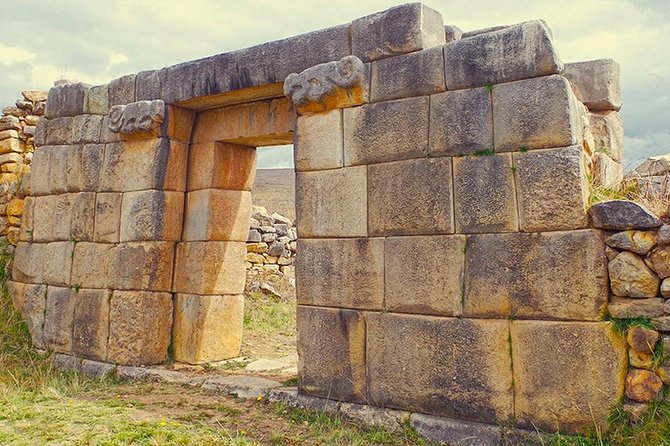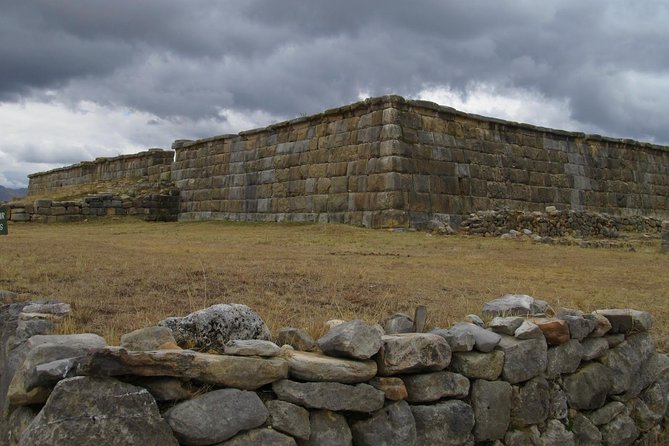The Inca Empire left an indelible mark on the Andean region, and at the heart of this vast civilization lay Huanuco Pampa. This extraordinary administrative and ceremonial center showcases the Incas’ unparalleled engineering prowess and cultural richness. From its intricate network of plazas and stone structures to its advanced urban planning, Huanuco Pampa offers a captivating glimpse into the sophisticated society that thrived in the region. As visitors explore this historical gem, they’ll uncover the vital role it played in trade, governance, and the Incas’ spiritual traditions – a testament to the enduring legacy of this remarkable Inca outpost.
Key Points

- Huanuco Pampa was a major administrative and ceremonial center of the Inca Empire, serving as a hub of power, trade, and cultural traditions.
- The site’s advanced architecture, including precisely fitted stone structures and sophisticated drainage systems, showcases the engineering prowess of the Incas.
- Huanuco Pampa’s strategic location near Inca roads and diverse ecosystems reinforced its importance as a crucial administrative and military stronghold.
- The Incas employed various sustainable agricultural practices, such as terraced farming and complex irrigation systems, to adapt to the high-altitude environment.
- Huanuco Pampa was a hub of spiritual and ceremonial activities, featuring grand plazas, temples, and altars that honored the Inca gods and traditions.
Overview of Huanuco Pampa
Nestled high in the Andes of Peru, Huanuco Pampa stands as a testament to the grandeur of the Inca Empire. This expansive site, once a major administrative and ceremonial center, reveals the Incas’ remarkable engineering and architectural feats.
Sprawling across a vast plateau, the ruins showcase an intricate network of plazas, storehouses, and impressive stone structures, all meticulously planned and constructed. Visitors can explore the remnants of this ancient metropolis, marveling at the Incas’ advanced urban planning and the site’s strategic location along important trade routes.
Huanuco Pampa offers a glimpse into the sophisticated civilization that once thrived in the Andes, leaving an indelible mark on the region’s history.
You can also read our reviews of more tours and experiences in Huaraz.
Exploring Inca Architecture

As visitors explore the ruins of Huanuco Pampa, they’re struck by the Incas’ remarkable architectural prowess.
The site’s massive stone structures, meticulously engineered, showcase the Inca’s advanced construction techniques. Precisely cut blocks of stone, fitted together without mortar, form the foundations of grand plazas, administrative buildings, and elite residences.
Archaeologists marvel at the Incas’ ability to move and precisely position these massive stones, a testament to their engineering ingenuity. Intricate drainage systems and sophisticated urban planning further demonstrate the Incas’ sophisticated understanding of architecture and urban design.
Exploring Huanuco Pampa is a window into the Inca Empire’s architectural sophistication and engineering achievements.
Significance of Huanuco Pampa
Huanuco Pampa was a crucial administrative and ceremonial center within the Inca Empire. The site’s strategic location and well-planned infrastructure made it an important hub for the Inca’s vast domain.
Some key aspects of its significance include:
-
Administrative Center: Huanuco Pampa served as a major administrative center, housing government offices, storehouses, and living quarters for Inca officials and their staff.
-
Ceremonial Functions: The site was the venue for important Inca rituals and festivals, reinforcing the empire’s cultural and religious traditions.
-
Commercial Activities: The site’s markets and workshops facilitated trade and the distribution of goods throughout the Inca realm.
Daily Life in the Inca Empire
Life within the vast Inca Empire was highly organized and structured. Daily routines revolved around agriculture, with each community member contributing to crop cultivation and animal husbandry.
Artisans specialized in textiles, metalwork, and pottery, while others served as administrators, priests, or soldiers. Strict social hierarchies regulated access to resources and decision-making.
The Inca closely monitored the empire’s population through a census system and controlled the movement of people through a network of roads and way stations. This centralized, efficient system enabled the Inca to mobilize labor and resources to maintain their expansive domain.
Huanuco Pampa’s Strategic Location
Nestled in the Andes Mountains, Huanuco Pampa occupied a strategic position within the expansive Inca Empire.
Its location offered several key advantages:
-
Proximity to major Inca roads and trade routes, facilitating the movement of people, goods, and information across the empire.
-
Access to diverse ecosystems and resources, from high-altitude pastures to lower-elevation farmland, supporting the needs of the large administrative center.
-
Visibility and defensibility, with the site perched on a hilltop overlooking the surrounding landscape, making it an ideal administrative and military stronghold.
These factors contributed to Huanuco Pampa’s importance as a hub of Inca power, administration, and cultural exchange.
Uncovering Inca Agricultural Practices
Amidst the expansive Inca Empire, the agricultural practices employed at Huanuco Pampa offer valuable insights into the sophisticated land management strategies of the Quechua people. Archaeological evidence suggests that the Incas utilized complex irrigation systems, terraced farming, and crop rotation to maximize agricultural output in this high-altitude environment. The following table highlights key features of Inca agricultural techniques at Huanuco Pampa:
| Technique | Purpose |
|---|---|
| Irrigation | Provide consistent water supply |
| Terracing | Optimize land use on steep slopes |
| Crop Rotation | Maintain soil fertility |
These innovative practices allowed the Incas to thrive in the challenging Andean climate, underscoring their deep understanding of sustainable land stewardship.
Spiritual and Ceremonial Traditions
The ancient Inca civilization at Huanuco Pampa was deeply rooted in spiritual and ceremonial traditions that permeated every aspect of daily life.
The Incas built grand plazas, temples, and altars to honor their gods and ancestors. They performed elaborate rituals and ceremonies, including:
-
Inti Raymi, the annual celebration of the sun god, marked by music, dance, and offerings.
-
Capacocha, a solemn ceremony that involved the sacrifice of children and other precious objects.
-
Waachaq, a ritual to commemorate the dead and maintain connections with the spiritual world.
These traditions were integral to the Inca worldview, shaping their social, political, and economic structures.
Visiting Huanuco Pampa Today
Visitors today can still experience the grandeur and spiritual essence of Huanuco Pampa, the former administrative center of the Inca Empire.
The site offers a guided tour that provides an immersive look into the Inca’s remarkable architectural and cultural accomplishments. For $890, travelers can explore the ruins, learn from a local guide, and enjoy lunch and transportation.
Though not wheelchair accessible, the moderate physical fitness required allows visitors to appreciate the scale and significance of this historical gem.
With a maximum of 15 participants, the tour offers an intimate encounter with Peru’s iconic Inca legacy at Huanuco Pampa.
Frequently Asked Questions
What Are the Transportation Options to Reach Huanuco Pampa?
Travelers can reach Huanuco Pampa via round-trip shared transfers in an air-conditioned vehicle. Hotel pickup and drop-off services are provided for selected hotels, allowing for a convenient and comfortable transportation experience.
Can I Extend My Stay at Huanuco Pampa Beyond the Tour Duration?
Travelers can extend their stay at Huanuco Pampa beyond the tour duration, though additional arrangements would need to be made separately. The tour operator doesn’t provide accommodation or activities outside the specified itinerary.
Are There Any Special Requirements for Individuals With Disabilities?
This tour isn’t wheelchair accessible and isn’t recommended for those with serious medical conditions. Travelers with disabilities should check with the tour operator about any special requirements or accommodations that may be available.
Can I Bring Additional Luggage Beyond the Stated Allowance?
The tour has a stated luggage allowance of 1 suitcase and 1 carry-on per traveler. However, you can inquire about excess luggage restrictions if you need to bring more. The tour operator can provide details on any additional fees or limitations.
What Are the Payment Methods Accepted for This Tour?
The tour accepts various payment methods, including credit/debit cards. Guests can reserve now and pay later for added flexibility. Inquiries about excess luggage fees should be made prior to booking.
Recap
Huanuco Pampa, a remarkable Inca administrative and ceremonial center, offers a captivating glimpse into the Empire’s architectural prowess, agricultural innovations, and enduring cultural traditions. This archaeological site in the Peruvian Andes invites visitors to enjoy the sophisticated civilization that once thrived there, shedding light on the Incas’ remarkable achievements and their pivotal role in Andean history.
More Tour Reviews in Huaraz
Not for you? Here's more things to do in Huaraz we have recnetly reviewed
- 4 Best Guided Tours In Huaraz
- 6 Best 4 Day Tours In Huaraz
- 11 Best Full-Day Tours In Huaraz
- 3 Best 2 Day Tours In Huaraz
- 3 Best 3 Day Tours In Huaraz
- 3 Best Lunch Experiences In Huaraz
- From Ancash: Trekking Huayhuash Queropalca |7Days-6Nights|
- From Ancash: Trekking Alpamayo Cedars |9Days-8Nights|
- Huaraz: Pastoruri Glacier Day Trip
- From Huaraz: Trekking Santa Cruz – Llanganuco 4D/3N
- From Ancash: Full Huayhuash Circuit Excursion:10Days-9Nights
- From Ancash: Huayhuash Queropalca Trekking 7 Days-6 Nights
